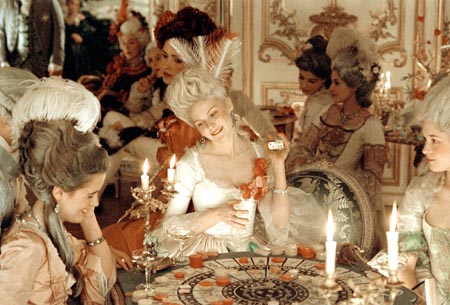|
Reviews of Recent Independent, Foreign, & Documentary Films in Theaters and DVD/Home Video
Written & Directed by: Sofia Coppola, based on the book by Antonia Fraser, Marie Antoinette: The Journey. Produced by: Coppola & Ross Katz. Director of Photography: Lance Acord. Edited by: Sarah Flack. Released by Columbia Pictures. Country of Origin: USA. 123 min. Rated: PG-13. With: Kirsten Dunst, Jason Schwartzman, Rip Torn, Judy Davis, Asia Argento, Marianne Faithfull, Danny Huston, Molly Shannon, Steve Coogan, Rose Byrne & Shirley Henderson. The revolution will not be dramatized. Instead, the world is cut off, and director Sofia Coppola’s confection of a biography remains almost entirely within the baroque walls of Versailles. Coppola based her film on Antonia Frasier’s 2001 book, Marie Antoinette: The Journey, which captured the complex political backdrop of late 1700s France, but an adaptation of her book would be a challenge for any filmmaker. Based on this tome, the last queen of France was not only politically naïve, but also vapid. As a result, the center of Coppola’s film is as light as a cream puff. Any tension while watching the film will be the result of having some knowledge beforehand of the time period, wondering if there will be any mention of the affair of the necklace or the attempts by Marie Antoinette’s husband, King Louis XVI, to reform his government. Nope. Though financing the American colonies’ revolt against England is blamed for helping to deplete France’s coffers. But Coppola is hardly the first to focus on the glitter and gaiety of Versailles. In his 1919 silent film Madame Du Barry (Passion), Ernst Lubitsch traced the rise and fall of King Louis XV’s mistress, Comtesse du Barry, Marie Antoinette’s rival in court (and in fashion), played in Coppola’s film with a snarly attitude by Asia Argento. In that film’s last five minutes, the king dies of smallpox, the revolution breaks out, and du Barry is guillotined. Abrupt, yes, but at least there’s momentum. By ending Marie Antoinette in 1790, three years before the queen would be sentenced to death, the film deflates the reason why she is a compelling figure, if at all. Her courage during her confinement, her plan to escape with her family from prison, and her ultimate death made her an honorary member of the Dead Blonde Hall of Fame. Her victimization made her an icon. Coppola’s young queen is a lot like the ingénue in her last film, Lost in Translation, the second film in the director’s trilogy of a girl’s transformation into womanhood (the first being 2000’s The Virgin Suicides.) Instead of Tokyo’s Park Hyatt, the foreigner, the archduchess from Austria, is adrift in the hostile and gossipy French court. In place of Translation’s jet-lagged disorientation, we get bemused resignation and ennui. On her way to marry the heir to the French throne, Marie Antoinette disembarks from her carriage at the Austrian and French border. The 14-year-old princess is stripped of her beloved pug and all of her clothes, her body scrutinized by strangers. Except for the separation of the dog and her Austrian companions, Kirsten Dunst’s queen is mostly amused and puzzled by the ways of the French, her predominate attitude for most of the film. Yet for a movie largely about mood, the script is entirely literal. After years of not consummating her marriage, Marie Antoinette realizes her position may be endangered. Walking down a corridor, she hears women whispering about her barrenness, wondering if she will ever produce an heir, underlying the only conflict that’s already apparent (and really the only one in the first half). Brushing aside her blues with shoes and sweets, Marie Antoinette and her ladies-in-waiting voraciously down sweets and champagne as the Bow Wow Wow anthem “I Want Candy,” blares out. (I guess the rights to “Girls Just Want to Have Fun” weren’t available.) And as she continues to kill time, there’s another montage of pastry stuffing. (Be sure to leave for dessert after the movie.) However, the anachronistic use of music actually gives the film much needed verve. Aside from the period music by Rameau, the soundtrack, most of it from the ‘80s, hasn’t dated, but is catchy or atmospheric and still hip – especially if you grew up in the Valley listening to KROQ 20 years ago. The opulent costumes and the sumptuous setting (much of the film was actually filmed in Versailles) take center stage thanks to the languid vignettes of the court’s stupefying rituals or Marie Antoinette’s life in her hideaway, Le Petit Trianon. If it weren’t for the soundtrack and the slangy dialogue, you would think it was a Merchant Ivory film. (It’s a shame the palace’s architect, Jules Hardouin Monsart, isn’t around to pick up awards for art direction.)
Dunst’s flat Valley Girl delivery is just one more ingredient into this Euro pudding, an actors’ free-for-all. The eclectic cast
includes fellow Americans Molly Shannon, a low-key Rip Torn, and Danny Huston, as Marie Antoinette’s brother Emperor Joseph, who unlike Dunst, adopts a pseudo-Mid-Atlantic dialect. Jason Schwartzman plays the bumbling and self-effacing Louis XVI. Unlike John C. Reilly’s role in Chicago as a similar sap, Schwartzman’s presence is nonexistent. He really is a wallflower, blending in with the wallpaper. The British Commonwealth is well presented (it is a costume drama, after all), including Judy Davis as a severe enforcer of etiquette. Casting directors, here’s your next Lady Bracknell.
Kent Turner
|

